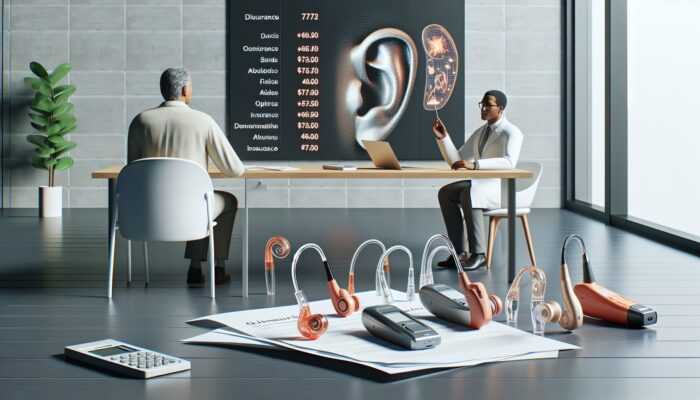Hearing Loss: A Common Issue for Tech Professionals

Last Updated on 28/11/2025 by Admin
Understanding the Primary Causes of Hearing Loss Among Tech Professionals
Assessing the Risks of Noise Exposure in Tech Workspaces
Prolonged exposure to elevated noise levels in technology environments poses a significant threat to hearing health. Many individuals working in tech are situated in open-office layouts or studios where the sounds of machinery, server fans, and loud communication devices are omnipresent. This incessant noise can create a setting where auditory well-being is jeopardized. For example, sound levels exceeding 85 decibels can inflict damage after prolonged exposure—a standard frequently surpassed in tech workplaces, especially in areas with machinery or during collaborative meetings where voices are raised to overcome background noise.
Additionally, the noise pollution experienced in tech settings is not limited to machinery; it also stems from team interactions, where professionals might listen to loud music or engage in high-volume conversations. The combined effects of such exposure can lead to irreversible auditory damage. Recognizing these risks is crucial for tech organizations to implement effective noise reduction strategies and educate their workforce about safe listening practices.
Exploring the Impact of Headphones and Earbuds on Hearing
The regular use of headphones and earbuds is a prominent contributor to hearing loss among tech professionals. Many individuals in the tech sector rely on personal listening devices for concentration, entertainment, or communication. However, extended use at high volumes, especially in noisy settings, can result in auditory fatigue and long-lasting damage. The combination of high volume and prolonged usage without breaks creates a critical scenario for potential hearing degradation.
To combat this risk, tech professionals are advised to follow the 60/60 rule: listen at 60% volume for no more than 60 minutes at a time. Taking regular breaks can significantly reduce the likelihood of hearing loss while maintaining engagement with audio content. Organizations should also raise awareness about this issue, advocating the use of noise-canceling headphones to minimize the necessity for high volume.
Investigating Genetic and Age-Related Influences on Hearing Loss
Beyond environmental factors, genetic predisposition and age-related changes play significant roles in the occurrence of hearing loss among tech professionals. Some individuals may inherit a genetic vulnerability to hearing loss, making them more susceptible regardless of their work environment. Additionally, as tech professionals age, they may encounter age-related auditory decline, commonly referred to as presbycusis.
This decline can be intensified by the demanding auditory conditions prevalent in tech jobs. For instance, an individual with years of experience in high-noise environments may experience accelerated hearing loss compared to peers in quieter roles. It is vital for tech professionals to undergo regular hearing evaluations, particularly as they age, to monitor changes and proactively manage potential issues.
Expert Insights: Real-World Experiences of Hearing Loss in Tech Professionals
Showcasing Real-Life Examples of Hearing Loss in the Tech Industry
Gaining insight into the real-life consequences of hearing loss among tech professionals is essential for recognizing the extent and impact of this issue. Below are case studies that illustrate various experiences:
- Software Engineer in Silicon Valley: After spending years in noisy offices lacking adequate soundproofing, this engineer developed <a href=”https://www.earwaxremoval.net/tinnitus-relief-top-tech-solutions-for-effective-relief/”>tinnitus</a>, which manifests as persistent ringing in their ears.
- Audio Technician in London: Regular exposure to loud sound levels during live events led this technician to notice a gradual decline in their ability to hear high frequencies, which negatively impacted job performance.
- Game Developer in Tokyo: This developer reported significant discomfort and difficulty understanding conversations in meetings, largely due to heavy reliance on headphones for extended periods.
- IT Support Specialist in Sydney: Working in a vibrant environment filled with server noises, this professional experienced a noticeable reduction in hearing, particularly in their right ear, which led to communication difficulties.
These case studies highlight the urgent need for awareness and proactive measures in managing hearing health within the tech sector. By sharing personal experiences, tech professionals can cultivate a community focused on preventive strategies and mutual support in maintaining hearing health.
Implementing Actionable Strategies for Hearing Loss Prevention
Tech professionals can adopt several practical steps to safeguard their hearing health and effectively manage any existing loss. Prioritizing regular hearing check-ups is essential, with annual screenings recommended to identify potential issues early. This proactive strategy enables timely interventions before hearing loss progresses.
Utilizing noise-canceling headphones is another effective tactic. These devices can significantly reduce background noise, allowing professionals to listen at lower volumes, thereby alleviating the strain on hearing. Furthermore, it is crucial to take breaks from loud environments. Short, frequent breaks can help alleviate auditory fatigue and provide the ears with essential rest periods.
Other management strategies include adopting good listening habits and lowering headphone volume. Utilizing speakerphone options during calls can also reduce reliance on earbuds. Collectively, these steps empower tech professionals to take control of their hearing health, significantly diminishing the risk of long-term hearing loss.
Analyzing the Long-Term Effects of Hearing Loss on Professionals
The long-term ramifications of hearing loss extend beyond simple auditory challenges; they can profoundly influence communication, social interactions, and cognitive function. For tech professionals, auditory difficulties can create significant barriers to effective communication in collaborative work environments. Misunderstandings during meetings or challenges in following conversations can induce stress and frustration.
Additionally, social isolation emerges as a concerning outcome. Individuals with hearing loss may withdraw from social engagements due to embarrassment or difficulties in conversation, leading to feelings of loneliness. Over time, this isolation can contribute to cognitive decline, affecting memory and focus. Experts stress the importance of addressing hearing loss early, as timely intervention can help mitigate these long-term consequences.
By fostering an understanding of the serious implications of untreated hearing loss, employers can advocate for improved workplace practices and support systems. Encouraging open discussions about hearing health can create a more inclusive environment that prioritizes employee well-being and productivity.
What Steps Can Tech Professionals Take to Safeguard Their Hearing?
What Best Practices Can Be Implemented for Effective Noise Reduction?
Implementing effective noise reduction practices is paramount for protecting hearing within the tech industry. Best practices include using noise-canceling headphones, which help minimize external sounds and reduce the necessity for high volume. Creating designated quiet workspaces is equally important, allowing tech professionals to take calls or concentrate on projects without the distractions of surrounding noise.
Organizations should also consider establishing noise reduction policies that promote designated quiet hours or spaces. Additionally, incorporating sound-absorbing materials into office designs can help minimize echo and reverberation. Engaging in regular training sessions focused on hearing health awareness can further promote safe listening practices among employees.
By fostering a culture of noise reduction within the workplace, tech companies can significantly lower the risk of hearing loss among their staff. This initiative not only enhances overall employee well-being but also improves productivity and job satisfaction.
How Frequently Should Hearing Tests Be Conducted?
Hearing tests should ideally be conducted on an annual basis for tech professionals, particularly those exposed to noisy environments, to monitor their auditory health effectively. Regular testing is vital, as it facilitates the early detection of any signs of hearing loss and provides an opportunity for timely intervention. If professionals are aware of existing hearing challenges or have noticed sudden changes, more frequent assessments become advisable.
Tech companies can support their employees by providing access to regular hearing screenings through workplace wellness programs or by partnering with audiology clinics. Encouraging employees to prioritize their hearing health fosters a proactive approach to managing potential issues before they escalate.
Establishing a routine around hearing health can help tech professionals remain vigilant about their auditory well-being, ultimately safeguarding their ability to communicate effectively in both personal and professional contexts.
What Essential Role Do Hearing Protection Devices Play?
Hearing protection devices, including earplugs and earmuffs, are vital in safeguarding against noise-induced hearing loss among tech professionals. These devices are especially critical for individuals working in high-noise environments where sound levels can exceed safe thresholds. Properly fitted earplugs can significantly mitigate harmful noise exposure, making them an essential tool for hearing conservation.
Earmuffs provide an additional layer of protection, particularly in circumstances where prolonged exposure to loud sounds is unavoidable. For tech professionals, wearing hearing protection during activities like server maintenance or working near heavy machinery can prevent cumulative damage to hearing.
Incorporating hearing protection into daily routines should be a priority for tech professionals, especially in noisy workplace settings. By recognizing the importance of these devices, employees can take proactive measures to preserve their hearing health.
What Signs of Hearing Loss Should Be Monitored?
Recognizing the signs of hearing loss is essential for early detection and effective management. Common indicators include difficulties understanding speech, particularly in noisy environments, persistent ringing in the ears known as tinnitus, and the need to increase volume levels on electronic devices. Other signs may include frequently asking others to repeat themselves or experiencing heightened sensitivity to loud sounds.
Tech professionals should remain vigilant regarding these symptoms. Early detection allows for prompt intervention, which can significantly enhance quality of life and long-term outcomes. If any signs are observed, seeking a professional evaluation is crucial to assess the extent of hearing loss and explore appropriate management options.
Fostering awareness around these signs can empower tech professionals to take charge of their hearing health, ultimately leading to improved overall well-being and job performance.
How Can Tech Professionals Foster a Hearing-Safe Work Environment?
Creating a hearing-safe work environment requires a combination of strategic planning and employee engagement. Tech professionals can begin advocating for noise reduction measures, such as implementing sound-absorbing materials in office spaces and utilizing acoustic panels. Reducing background noise is essential in creating a more conducive environment for concentration while simultaneously protecting hearing health.
Promoting awareness about hearing health among colleagues is also vital. Regular workshops or seminars highlighting the importance of hearing conservation can help cultivate a culture of safety. Furthermore, encouraging breaks from noisy environments can significantly reduce the risk of auditory fatigue.
By prioritizing a hearing-safe workplace, tech professionals can contribute to a supportive culture that values employee well-being. Implementing these strategies not only protects hearing but also fosters a more productive and collaborative work environment.
Recognizing Symptoms and Diagnosing Hearing Loss
Identifying Common Signs of Hearing Loss
Awareness of the common signs of hearing loss is crucial for timely intervention. Symptoms often include difficulties understanding speech, particularly in noisy settings, and persistent ringing in the ears, known as tinnitus. Tech professionals may also find themselves needing to increase the volume on devices or frequently asking others to repeat themselves. Initially subtle, these signs can escalate if not addressed.
Another common indicator is experiencing increased sensitivity to loud sounds, making everyday environments feel overwhelming. Recognizing these symptoms early allows for prompt action, potentially preventing further deterioration of hearing. It is essential for tech professionals to maintain open communication regarding their hearing health, fostering a workplace culture that prioritizes auditory well-being.
Awareness surrounding these signs can lead to more proactive measures in seeking help, ultimately benefiting both personal and professional interactions.
Understanding Diagnostic Tests and Procedures
Diagnostic tests are integral in identifying the type and severity of hearing loss. Common procedures include audiometry, which assesses the ability to hear various frequencies, and tympanometry, which evaluates eardrum function. Otoacoustic emissions testing is another valuable method that measures sound waves produced in the inner ear, providing insights into cochlear function.
These tests are typically conducted by audiologists and help establish a comprehensive understanding of an individual’s hearing capacity. For tech professionals, undergoing these assessments can clarify the specific nature of any auditory difficulties experienced.
Engaging in these diagnostic procedures early can lead to effective management strategies, ensuring that tech professionals maintain optimal auditory health.
When Should Professional Help Be Sought?
Tech professionals should seek professional assistance if they experience persistent hearing difficulties or notice a decline in their hearing capabilities. Early signs, such as trouble understanding conversations during meetings or increased ringing in the ears, warrant prompt consultation with an audiologist. Recognizing these signs early can lead to timely diagnosis and intervention, preventing further deterioration.
It is also advisable to seek professional help if there are concerns about hearing health, such as sudden hearing loss or noticeable changes in auditory perception. Establishing a routine of regular hearing check-ups can facilitate ongoing monitoring and proactive management of hearing health.
Seeking help at the right time can significantly improve outcomes, empowering tech professionals to maintain effective communication and a fulfilling professional life.
Understanding the Importance of Early Detection
Early detection of hearing loss is crucial in preventing further damage and enhancing treatment outcomes. Regular hearing checks are essential for maintaining auditory health, particularly for tech professionals exposed to high-decibel environments. Identifying hearing issues early allows for timely intervention, which can slow the progression of hearing loss.
Moreover, early intervention strategies may include lifestyle changes, assistive devices, or auditory rehabilitation programs that can greatly improve quality of life. Promptly addressing hearing loss can also avert the associated risks of social isolation and cognitive decline, which often accompany untreated hearing issues.
By prioritizing early detection, tech professionals can safeguard their auditory health, ensuring continued productivity and engagement in their personal and professional lives.
Exploring Treatment Options for Hearing Loss
Utilizing Hearing Aids and Assistive Devices
Hearing aids and assistive devices are crucial tools for tech professionals managing hearing loss. These devices amplify sound, enhancing communication and overall auditory experiences. Modern hearing aids come in various styles and technologies to cater to diverse needs and preferences. Advanced hearing aids now offer features such as Bluetooth connectivity, allowing seamless integration with smartphones and other devices.
For tech professionals, utilizing hearing aids can significantly improve their ability to participate in meetings, collaborate with colleagues, and engage in social interactions. Additionally, assistive devices, such as amplified telephones or alerting systems, provide further support, ensuring that individuals remain connected and informed in their work environments.
Adopting hearing aids and assistive devices can lead to improved job performance and enhanced quality of life, facilitating more effective communication in both professional and social contexts.
Considering Surgical Interventions for Severe Hearing Loss
In severe cases of hearing loss, surgical interventions may be necessary to restore or enhance auditory function. Procedures such as cochlear implants or stapedectomy can offer significant benefits for individuals with profound hearing impairment. Cochlear implants are electronic devices that bypass damaged hair cells in the inner ear, directly stimulating the auditory nerve, while stapedectomy involves removing and replacing the stapes bone in the middle ear.
These surgical options can dramatically improve the hearing experience for tech professionals facing debilitating hearing loss. While surgery may not be appropriate for every individual, it is essential to discuss these options with an audiologist or ENT specialist if conventional treatment methods have proven ineffective.
Understanding the range of surgical interventions available can empower tech professionals to make informed decisions regarding their hearing health and pursue the best course of action tailored to their unique situations.
What Advantages Does Auditory Rehabilitation Provide?
Auditory rehabilitation offers significant advantages for tech professionals adapting to hearing loss. Through therapy and communication strategies, individuals can learn to navigate their auditory environments more effectively. This rehabilitation may include training on how to use hearing aids, techniques for improving speech understanding, and strategies for managing conversations in noisy settings.
The rehabilitation process often involves support groups or counseling, addressing the emotional and psychological aspects of hearing loss. This holistic approach can greatly enhance quality of life and professional performance, enabling tech professionals to regain confidence in their communication abilities.
By investing in auditory rehabilitation, individuals can cultivate resilience, adapt to their hearing challenges, and improve their overall well-being in both personal and professional domains.
Implementing Preventive Measures and Lifestyle Adjustments
Preventive measures and lifestyle adjustments are critical for effectively managing hearing loss. First and foremost, protecting ears from loud noise is essential; this can involve wearing hearing protection in noisy environments, taking regular breaks from sound exposure, and being mindful of personal listening volume levels.
Moreover, maintaining overall health through a balanced diet, regular exercise, and avoiding smoking can positively influence hearing health. Staying hydrated and managing stress are also vital, as these factors can impact overall auditory function.
By adopting these preventive measures and making conscious lifestyle adjustments, tech professionals can significantly reduce the risk of further hearing loss and enhance their ability to manage existing conditions effectively.
How Does Hearing Loss Impact Career Advancement?
Addressing Communication Challenges in the Workplace
Hearing loss can lead to substantial communication challenges in the workplace, significantly affecting job performance. Individuals with hearing loss often struggle to comprehend their colleagues, particularly during group discussions or meetings where multiple voices may overlap. This difficulty can result in misunderstandings, missed information, and an overall sense of frustration.
Moreover, reliance on visual cues, such as lip-reading, can be taxing and may not always be feasible in a fast-paced tech environment. These communication challenges can impede collaboration and limit participation in team activities, ultimately affecting opportunities for career advancement.
Tech professionals must advocate for open communication about their hearing health. By fostering a supportive work environment that accommodates hearing challenges, organizations can enhance collaboration, productivity, and job satisfaction for all employees.
Assessing the Impact of Hearing Loss on Job Performance
Hearing loss can adversely affect job performance by leading to misunderstandings and missed information. Tech professionals may struggle to follow complex discussions or misinterpret instructions, resulting in errors and decreased productivity. This cycle of stress can exacerbate hearing difficulties, potentially causing further declines in auditory health.
Additionally, the emotional toll of hearing loss can diminish job satisfaction. Professionals may feel isolated or disengaged from team dynamics, ultimately affecting morale. Employers must acknowledge the impact of hearing loss on job performance and provide appropriate support and accommodations.
Creating an inclusive work environment that emphasizes understanding and support for hearing loss can help tech professionals thrive, ensuring they maintain their performance while addressing their auditory challenges.
Exploring Strategies for Career Advancement Despite Hearing Loss
Despite the challenges posed by hearing loss, tech professionals can still pursue strategies for career advancement. One effective approach is to be transparent about hearing difficulties with employers and colleagues. Disclosing hearing loss can foster understanding and encourage support within the team.
Utilizing assistive technologies, such as speech-to-text software or hearing aids, can enhance communication capabilities and ensure meaningful participation in meetings and collaborative projects. Seeking accommodations, such as flexible workspaces or modified communication methods, can also assist in navigating workplace dynamics effectively.
Engaging in professional development opportunities, like workshops or seminars focusing on communication strategies for those with hearing loss, can further empower tech professionals to enhance their skills and boost their confidence. By actively addressing hearing challenges, individuals can continue to advance their careers and reach their goals.
Research-Backed Advantages of Addressing Hearing Loss
Enhancing Cognitive Function Through Effective Hearing Management
Addressing hearing loss has been linked to improved cognitive function, including enhanced memory and attention. Research indicates that individuals who effectively manage their hearing health report superior cognitive performance, especially in environments requiring multitasking or complex problem-solving. For tech professionals, these cognitive benefits can translate into better job performance and overall effectiveness in their roles.
Maintaining cognitive health through appropriate interventions for hearing loss can assist tech professionals in navigating the demands of their work more adeptly. Engaging with assistive technologies and participating in rehabilitation programs can foster auditory processing skills, contributing to improved mental agility.
By prioritizing hearing health, tech professionals can enjoy the dual advantages of enhanced hearing and cognitive function, leading to greater success in both personal and professional spheres.
Improving Quality of Life Through Hearing Health Management
Addressing hearing loss can significantly improve the quality of life for tech professionals. Enhanced communication promotes more fulfilling interactions, reducing social isolation and fostering stronger relationships. Improved auditory experiences contribute to greater enjoyment of various activities, from attending events to engaging with family and friends.
Furthermore, the psychological benefits of managing hearing loss are substantial. Alleviating feelings of frustration and embarrassment associated with communication challenges can lead to improved self-esteem and overall well-being. Tech professionals who prioritize their hearing health frequently report higher levels of job satisfaction and personal fulfillment.
Focusing on effective management of hearing loss not only improves communication but also enriches overall experiences, positively impacting both personal and professional life.
What Long-Term Benefits Come from Early Intervention?
Early intervention in addressing hearing loss offers numerous long-term benefits. By taking proactive measures, individuals can prevent further auditory decline, ensuring that their hearing health remains stable over time. This preventive approach promotes better communication skills, allowing tech professionals to maintain strong interpersonal relationships and effective collaboration.
Moreover, early intervention can enhance cognitive health, preventing potential declines associated with untreated hearing loss. Individuals who manage their hearing effectively often experience improved job performance and a greater capacity for career advancement.
Investing in early intervention strategies, such as regular hearing tests and the adoption of assistive devices, can yield lasting benefits, ensuring tech professionals remain engaged and productive throughout their careers.
Boosting Workplace Productivity Through Hearing Health Management
Addressing hearing loss is vital for enhancing workplace productivity. Professionals who effectively manage their auditory health can communicate more clearly, reducing misunderstandings and improving collaboration. Enhanced communication fosters smoother workflows, enabling teams to operate more effectively and achieve their goals.
Moreover, by alleviating the stress associated with hearing challenges, individuals can concentrate more on their work, resulting in higher levels of job satisfaction and motivation. Tech professionals who prioritize their hearing health often exhibit increased engagement, contributing to a positive workplace culture.
Incorporating strategies to address hearing loss not only enhances individual productivity but also cultivates a collaborative environment where all team members can thrive.
Technological Innovations Advancing Hearing Health
Recent Developments in Hearing Aid Technology
Recent advancements in hearing aid technology are revolutionizing the auditory experiences of individuals with hearing loss. Modern hearing aids are smaller, more discreet, and equipped with improved sound quality. Many devices now offer connectivity with smartphones and other technologies, allowing users to customize their listening experiences effortlessly.
For tech professionals, these innovations can dramatically enhance communication and overall quality of life. Features such as automatic sound adjustments, directional microphones, and noise reduction technology empower individuals to navigate various auditory environments effectively.
By embracing these advancements, tech professionals can enjoy a more seamless integration of hearing aids into their daily routines, enhancing both their work and personal lives.
What Role Do Smart Devices Play in Supporting Hearing Health?
Smart devices play a pivotal role in supporting hearing health among tech professionals. These devices can monitor noise exposure, facilitate access to hearing tests, and seamlessly connect with hearing aids for personalized settings. The integration of technology into hearing management has transformed how individuals approach their auditory health.
Key features of smart devices that support hearing health include:
- Noise level monitoring to alert users of high-decibel environments.
- Hearing tests that can be conducted via apps for convenient self-assessment.
- Integration with hearing aids for customized sound adjustments.
- Access to educational resources on hearing health and preventive measures.
By leveraging the capabilities of smart devices, tech professionals can actively manage their hearing health in real-time, leading to better outcomes and a proactive approach to auditory wellness.
Anticipating Future Trends in Hearing Protection and Enhancement
The future of hearing protection and enhancement appears promising, characterized by innovative approaches and technologies. Trends may include personalized hearing solutions that adapt to individual auditory profiles, making hearing aids more effective for specific hearing needs. AI-driven hearing aids are also on the horizon, offering real-time sound analysis and automatic adjustments based on environmental conditions.
Advanced noise-canceling technologies are expected to evolve, providing enhanced protection in various work environments. Furthermore, wearable devices with integrated hearing health monitoring capabilities may become commonplace, leading to more comprehensive management of auditory health.
By embracing these future trends, tech professionals can look forward to improved hearing health solutions that enhance their work experiences and support their overall well-being.
Frequently Asked Questions About Hearing Loss
What Are the Primary Causes of Hearing Loss in Tech Professionals?
The primary causes encompass prolonged noise exposure in the workplace, frequent use of headphones at high volumes, and genetic or age-related factors.
How Can Tech Professionals Effectively Prevent Hearing Loss?
Preventive measures include utilizing noise-canceling headphones, taking regular breaks from loud environments, and scheduling consistent hearing check-ups.
What Signs of Hearing Loss Should Be Monitored?
Signs include difficulties understanding speech, experiencing ringing in the ears (tinnitus), and frequently needing to increase device volume.
How Often Should Hearing Tests Be Conducted?
Hearing tests should ideally occur annually or more frequently if there are known risks or noticeable changes in hearing ability.
What Role Do Hearing Protection Devices Serve?
Hearing protection devices, such as earplugs and earmuffs, help reduce exposure to harmful noise levels, preventing the risk of hearing loss.
What Are the Long-Term Effects of Untreated Hearing Loss?
Untreated hearing loss can lead to communication difficulties, social isolation, and cognitive decline, negatively affecting both personal and professional life.
How Can Tech Professionals Create a Hearing-Safe Work Environment?
Creating a hearing-safe environment involves reducing background noise, utilizing sound-absorbing materials, and promoting awareness about hearing health among colleagues.
What Treatment Options Are Available for Hearing Loss?
Treatment options include hearing aids, assistive devices, surgical interventions, and auditory rehabilitation programs.
What Are the Benefits of Early Intervention for Hearing Loss?
Early intervention can prevent further hearing loss, enhance cognitive function, and improve overall quality of life, leading to better long-term outcomes.
How Does Hearing Loss Affect Job Performance?
Hearing loss can lead to communication challenges, misunderstandings, and increased stress, ultimately impacting productivity and job satisfaction.
Explore our world on X!
The post Hearing Loss: A Common Issue for Tech Professionals appeared first on The Microsuction Ear Wax Removal Network.
The post Hearing Loss: A Common Issue for Tech Professionals appeared first on Healthcare Marketing Service.




























